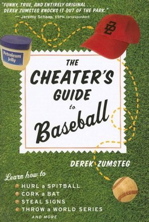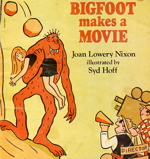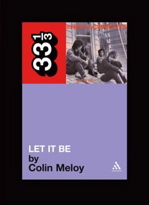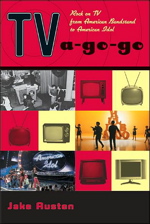| SteveMandich.com | Blog | Bio | Evel Incarnate | Back to Other Stuff | Contact |

The Cheater's Guide to Baseball
Was it cheating when, on May 27, 1981, Mariner third baseman Lenny Randle dropped to all fours on the Kingdome turf and blew a slow roller into foul territory?
Was it cheating when, on June 12, 1970, Pirate pitcher Doc Ellis threw a no-hitter while tripping on LSD?
Was it cheating when, well, all those times you smuggled your own booze into Safeco Field, and then snuck down to the Diamond Club seats?
Unfortunately, Seattle scribe Derek Zumsteg doesn't address these issues in The Cheater's Guide to Baseball, but his fun new book deals with pretty much every other cheating-related topic, from the hidden-ball trick to Barry "BALCO" Bonds. Zumsteg, the guy behind the popular U.S.S. Mariner blog, defines cheating as a way "to gain through deception, whether or not that deception is legal," and delves in from there.
However, Cheater's Guide gets off to a relatively slow start, describing the rough 'n' dirty tactics of baseball's earliest decades as personified by John McGraw. Other "underhanded but not illegal" strategies covered here are sign stealing (a key factor in Bobby Thomson's pennant-winning Shot Heard 'Round the World) and groundskeeping practices that favor home teams (i.e., the 1981 game when Mariner skipper Maury Wills had the Kingdome grounds crew draw the batter's box six inches closer to the mound).
Other managers are cited for trying to manipulate umpires, including Lou Piniella and his epic tantrums, and the irrepressible Billy Martin (whom Zumsteg lauds as "a cheater's cheater"). The chapter on "Delaying the game for fun and profit" is particularly resonant in light of Mike Hargrove craftily saving the M's from a likely loss at Cleveland's snowed-out home opener last month. On the other hand, the chapter on fan participation strays too far off-topic, even so, it fails to mention the biggest mass-heckling incident in memory, the Fenway faithful's infamous chant of "Daaaar-ryl! Daaaar-ryl!"
The book gets way better in its second hundred pages, dealing with the meatier, clearly illegal sins of corked bats and doctored balls. Zumsteg gives excellent historical analyses of both; too bad he didn't reveal the craftsmen who do the actual woodwork on corked bats (crooked equipment managers? Moonlighting shop teachers?) A couple Mariner pitchers pop up here: Rick Honeycutt, who in 1980 was busted for scuffing balls with a thumbtack, and of course, notorious spitballer Gaylord Perry, who Zumsteg declares the "Greatest Cheater Ever."
Finally, Zumsteg addresses what he regards as baseball's two worst forms of cheating: gambling and steroids. Rampant gambling plagued the sport until matters came to a head with the 1919 Black Sox scandal, which gets solid coverage (even if this cheating is driven by financial gain, not winning). Afterwards, the game remained mostly of such problems until Charlie Hustle came along; Zumsteg adequately explains why it was wrong of Pete Rose to bet on his Reds -- even to win -- and why he shouldn't be enshrined in the Hall of Fame.
Less troublesome to Zumsteg are steroids. He rationally ponders the grey areas a bit more than most knee-jerk reactions ("Steroids aren't bad. Steroid abuse is.") Sure, abuse is problematic, Zumsted argues, but steroid-aided records are no less valid than records set before baseball was integrated (hey, Babe Ruth!), or when spitballs were legal, or when parks were bigger, or when pitcher's mounds were higher.
As for the book's approach of dredging up scandal in a humorous manner, Cheater's Guide isn't as good as Richard Scheinin's1994 classic Field of Screams. Zumsteg's first-person approach often distracts from the subject matter, and he gets a little too cute with the wisecracks, especially in his excessive, often irrelevant sidebars: one talks about placing bets on ballplayers' nose-picking habits, another about betting on the length of the National Anthem. Zumsteg could stand to be a bit more philosophical in exploring the fine ethical line between simple strategy and outright cheating but, he rightly concludes, cheating has always been integral to baseball, and the sport is all the more intriguing because of it.
If The Cheater's Guide to Baseball were a batting average, it'd hover around 300.
Originally appeared in the June 2007 issue of The Grand Salami.
|

Bigfoot Makes a Movie
Syd Hoff, who wrote and illustrated the 1958 children's classic Danny and the Dinosaur, here offers his interpretation of how Bigfoot looks, and also how he sounds -- kerblap, kerblop is the onomatopoeia Bigfoot's footfalls make, repeated throughout this charming 48-page picture book.
"Young Bigfoot ran into his mother and father," the book begins. "He was so excited he could hardly grunt."
He tells his parents about some people he saw, but his father warns him to stay away from humans. Though Bigfoot doesn't understand why, he obeys. He then only spies on hunters, rangers and campers from his hiding spots in the forest. He's amused by their small feet.
One day, Bigfoot is thrilled to run into another Bigfoot. Even though he doesn't know him, Bigfoot excitedly gives the other Bigfoot a hug. However, the strange Bigfoot's fur slides off the body to reveal a man -- a man in costume who, by coincidence, is starring in a Bigfoot movie that's shooting in the area. The man runs away, and the rest of the cast and crew mistake the real Bigfoot for the actor. Since Bigfoot is curious, lonely, and hungry for friends, he willingly plays along.
The DeMille-like director instructs the Edith Head-like makeup woman to make Bigfoot look meaner, so she messes up his hair and gives him fangs, a big fake nose and furry eyebrows. Then a swishy, mustachioed wardrobe man touches up what he mistakenly thinks is Bigfoot's costume. Then Bigfoot acts in a scene, saving a damsel in distress from the face of a dangerous cliff (as depicted on the cover). Suddenly the actor playing Bigfoot emerges from the trees, and the cast and crew quickly realize they were interacting with the real Bigfoot all along. The frightened humans flee to their vehicles and speed out of the forest, leaving a confused Bigfoot behind.
"Bigfoot smiled," however. "He would keep on trying. Someday he would meet some humans who would want to be friends."
I give this book thirty-seven stars!
Posted on December 1, 2006.
|

Let It Be
Since 2003, Continuum has published some 26 mini-books in its 33 1/3 series, in which various authors write at length about a favorite album. The first one I've read is the series' 16th volume, Colin Meloy's take on the Replacements' Let It Be, simply because the album is also a personal favorite of mine. Granted, it's not my overall favorite 'Mats disc (that honor goes to Pleased to Meet Me, which is actually my favorite album of all-time), but Let It Be is still a record I'd love to learn more about... Like, how in the hell did Westerberg, Mars and the Stinsons get away with that title without a lawsuit by Apple Records?
Unfortunately, this book contains no such insight. Meloy, frontman for indie-rock stars the Decemberists, begins with a ho-hum tale of how he bought a Let It Be tape when he was ten. He then chronicles his awkward pre-teen years in Helena, Montana, scarcely addressing the album for the next 30 pages (over a third of the way into the book). From there on, Let It Be seemingly represents just one part of the college-rock soundtrack for Meloy's small-town, late-'80s version of The Wonder Years.
Meloy explains in the book's foreword that Let It Be edged out releases by Robyn Hitchcock and the Smiths, though it seems a book about Globe of Frogs or The Queen is Dead would've told his coming-of-age story just the same. Of course, there are probably Decemberists fans who'll buy the book regardless of his chosen album, which is fine for them.
It's also fine that the 33 1/3 series apparently grants its authors the freedom to approach their respective records in any manner they wish, but I bought this book to read about Let It Be, not Meloy. The book sheds little light on the album and its creators, and when Meloy finally does give them his full attention, he only offers a short series of imaginary vignettes about the Replacements' early years. Though he's obviously a fan, he fails to demonstrate why this album in particular matters so much to him, or why it should matter anyone else. Worse, unlike Micheal Azerrad's far superior Replacements chapter in Our Band Could Be Your Life, Meloy's book couldn't even persuade me to give my own Let It Be CD a long-overdue listen. Buy from Amazon.com.
Posted January 18, 2006.
|

TV A-Go-Go: Rock on TV from American Bandstand to American Idol
Jake Austen's fascinating new book is perhaps the definitive account of the ongoing collision between two of America's biggest pop-culture institutions: television and rock 'n' roll. Ever since their respective explosions in the 1950s, both media behemoths have held a huge popular sway; Austen's authoritative book explores their many intersections, along with their often glorious, often disastrous results.
Austen's 50-year, 369-page history begins with rock's 1955 TV debut, when non-rock fan Ed Sullivan welcomed Bo Diddley to his weekly talent cavalcade. Austen goes on to dissect American Bandstand, the powerhouse program hosted by shrewd capitalist Dick Clark, who also proves to be far less a rock fan. Regardless, Bandstand paved the way for other star-studded teen dance shows like Shindig, Hullaballoo, and the venerable Soul Train, as well as numerous shows that only aired in regional markets around the country. (Austen himself produces the Windy City public-access dance show Chic-a-Go-Go, along with the fantastic fanzine Roctober.)
The book moves forward in approximate chronological order: The '60s were dominated by pre-fab, made-for-TV rock bands, whether for one-shot sitcom appearances (the Mosquitoes on Gilligan's Island, the Gories on Gidget), or for an entire series (The Monkees, The Partridge Family). The earthier '70s brought Midnight Special, Don Kirshner's Rock Concert, variety shows like Donny and Marie and Saturday Night Live, and the ridiculous made-for-TV movie KISS Meets the Phantom of the Park. The so-called "MTV revolution" of the '80s heightened the previously unappreciated music video to an art form, and then shoved it aside in the '90s for non-music fare like The Real World, a precursor to the reality TV phenomenon. Rock has its own reality shows too, like MTV's The Osbournes, bringing TV rock full circle in the '00s: televised talent shows like American Idol are pretty much the same as TV's earliest fare, such as Ted Mack's Original Amateur Hour.
Austen's infectious enthusiasm for cathode-ray rock is most apparent in his chapter on televised punk, discussing the Clash on Fridays and Fear on SNL, and and the fictional, "evil" punk bands on Quincy and CHiPs. Another chapter depicts Michael Jackson as the ultimate TV rock star: he appeared on Ed Sullivan, his own cartoon show, countless '70s variety shows, and Soul Train. After sparking MTV's massive '80s success, Jacko's subsequent life has uncannily resembled today's popular reality shows.
The book's tone is too enthusiastic to be scholarly, yet its analysis is serious enough so as to not be dismissed like so much bubblegum music (which Austen obviously loves). His opinions are refreshingly clear, particularly on issues of race (as it pertains to American Bandstand, American Idol, and MTV), credibility ("Milli Vanilli is totally legitimate"), and lip-synching, which is how the vast majority of televised music is presented. "Lip-synching is an art form and a convenience and has been an integral part of pop music -- especially on TV -- for more than half a century," Austen writes. "For any elitists who can't dig this, read my lips: 'Get over it.'"
Through all eras, Austen values a band's overall entertainment impact over any notions of "authenticity." Thus, Alvin & the Chipmunks are just as "real" to their fans as, say, Fugazi is to theirs. Likewise, William Hung's atonal warblings on Idol are just as worthy as Elvis or the Beatles on Sullivan. Whether they're fictional acts created for TV (Josie & the Pussycats), real-life acts performing on TV (Patti Smith on Kids are People Too), or combinations of the two (O Town, which formed on the ABC's reality show Making the Band), if they rock, they're real.
As engaging and near-thorough as TV A-Go-Go is, there's nary a word on 1985's massive Live Aid concerts, probably the most-widely seen rock-on-TV event to date. More glaring, however, is the omission of the classic What's Happening!!? episode where Rerun gets busted by the Doobie Brothers for making a bootleg concert tape. Otherwise, it's killer. Buy from Amazon.com.
Posted November 2005.
|
|
© 2004-2011 Steve Mandich |